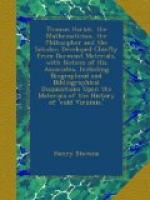A little more than a month after the execution of his friend, Hariot is found in his observatory at Sion taking observations of the comet of December 1618. His valuable observations are preserved among his mathematical papers. During the eleven years following his primitive observations of the ’ Hariot’ comet of 1607, first at Ilfracombeand later at Kidwely, great advances had been made in the science of astronomy, chiefly in consequence of the invention of the telescope, and the discoveries by means of it. No mathematician in Europe was probably further advanced in this science than Hariot.
What particular discoveries belonged to him and what to Galileo, Kepler and other contemporaries, it is very difficult to determine, since it is now positively known that from 1609 or 1610 Hariot was a manufacturer and dealer in lenses, or perspective glasses, as well as in perspective trunks or telescopes; and that he was in correspondence with Kepler, and probably with Galileo. He was easily the chief of astronomers in England, and is known to have possessed the earliest books of Galileo and to have sent them to his disciples, Lower and Protheroe, in Wales. Respecting this comet of 1618, he was in correspondence with Alien and Standish of Oxford and other scholars at home and abroad.
In ’Certain Elegant Poems, Written By Dr. [Richard] Corbel, Bishop of Norwich. R. Cotes for Andrew Crooke, 1647, 16°- The mirth-loving Bishop, in ’A Letter sent from Doclor Corbetto MaJler [Sir Thomas] Ailebury, Decem. 9. 1618’ [on the Comet of that year] is the following allusion to Hariot:
Burton to Gunter Cants, and Burton heares From Gunter, and th’ Exchange both tongue & eares By carriage : thus doth mired Guy complaine, His Waggon on their letters beares Charles Waine, Charles Waine, to which they fay the tayle will reach And at this diftance they both heare, and teach. Now for the peace of God and men, advise (Thou that haft wherewithall to make us wise) Thine owne rich ftudies, and deepe Harriots mine, In which there is no drosse, but all refine, O tell us what to trust to, lest we wax All stiffe and tupid with his paralex ; Say, shall the old Philofophy be true ? Or doth he ride above the Moone think you ? etc.
After the departure of the ’ Blazing Starr’ of December 1618, very little is known of Hariot, except that he lived at Sion while his patron the Earl was still in the Tower, where he was probably frequently visited by his man of science. The following letter, dated the 19th of January 1619, to him at Sion from Sir Thomas Aylesbury is interesting as showing the great interest taken in his old master by his ’ loytering scholar.’ Many other letters of this stamp, breathing love and ardent friendship, are found among the Hariot papers, from Sir William Lower, Sir John Protheroe, Sir Ferdinando Gorges, Dr Turner, and Sir Thomas Aylesbury. Here is a sample:




